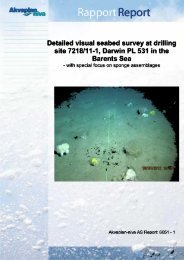Carbaryl
Carbaryl
Carbaryl
Create successful ePaper yourself
Turn your PDF publications into a flip-book with our unique Google optimized e-Paper software.
AGRICULTURAL USE REQUIREMENTS<br />
Use this product only in accordance with its labeling and with the Worker Protection Standard, 40 CFR part 170. This Standard<br />
contains requirements for the protection of agricultural workers on farms, forests, nurseries, and greenhouses, and handlers of<br />
agricultural pesticides. It contains requirements for training, decontamination, notification, and emergency assistance. It also contains<br />
specific instructions and exceptions pertaining to the statements on this label about personal protective equipment (PPE) and restrictedentry<br />
interval. The requirements in this box only apply to uses of this product that are covered by the Worker Protection Standard.<br />
Do not enter or allow worker entry into treated areas during the restricted entry interval (REI) of 12 hours.<br />
PPE required for early entry to treated areas that is permitted under the Worker Protection Standard and that involves contact with<br />
anything that has been treated, such as plants, soil, or water is coveralls, chemical-resistant gloves such as barrier laminate, nitrile<br />
rubber, neoprene rubber, or viton, shoes plus socks, and chemical-resistant headgear for overhead exposure.<br />
NON-AGRICULTURAL USE REQUIREMENTS<br />
The requirements in this box apply to uses of this product that are NOT within the scope of the Worker Protection Standard<br />
for agricultural pesticides (40 CFR Part 170). The WPS applies when this product is used to produce agricultural plants on<br />
farms, forests, nurseries, or greenhouses.<br />
The area being treated must be vacated by unprotected persons.<br />
Keep unprotected persons out of treated areas until sprays have dried.<br />
Do not contaminate water, food or feed by storage or disposal.<br />
STORAGE<br />
STORAGE AND DISPOSAL<br />
Store unused SEVIN ® brand XLR PLUS <strong>Carbaryl</strong> Insecticide in original container only, in cool, dry area out of reach of children and<br />
animals. Do not store in areas where temperatures frequently exceed 100°F.<br />
If container is damaged, before cleaning up, put on Personal Protective Equipment.<br />
PESTICIDE DISPOSAL<br />
Open dumping is prohibited. Wastes resulting from the use of this product may be disposed of on site or at an approved waste disposal<br />
facility<br />
CONTAINER DISPOSAL<br />
Triple rinse (or equivalent). Then offer container for recycling or reconditioning or puncture and dispose of container in a sanitary<br />
landfill, by incineration, or, if allowed by state and local authorities, by burning. If container is burned, stay out of smoke.<br />
GENERAL CAUTIONS AND RESTRICTIONS<br />
SEVIN ® brand XLR PLUS <strong>Carbaryl</strong> Insecticide is a suspension of microfine SEVIN ® brand carbaryl insecticide in an aqueous medium.<br />
It readily disperses in water to form a spray which may be applied by air or ground.<br />
PLANT RESPONSE PRECAUTIONS<br />
Application to wet foliage or during periods of high humidity may cause injury to tender foliage.<br />
Do not use on Boston Ivy, Virginia creeper and maidenhair fern as injury may result. <strong>Carbaryl</strong> may also injure Virginia and sand pines.<br />
The use of adjuvants may increase the potential for crop injury to sensitive crops.<br />
PREHARVEST AND GRAZING RESTRICTIONS AND LIMITATIONS<br />
Tolerances established under the Federal Food, Drug and Cosmetic Act permit the sale of labeled crops bearing probable carbaryl<br />
residues when this product is used in accordance with the label directions. If used as directed, treated forage may be grazed or used as<br />
feed for dairy and meat animals without causing illegal residues in meat or milk. Do not apply at greater rates or at more frequent<br />
intervals than stated on the label. To do so may result in illegal residues in crops, meat, and milk.<br />
Do not use reclaimed irrigation water from crops treated with carbaryl on crops for which carbaryl tolerances are not established.<br />
Do not plant rotational food and feed crops not listed on this or other carbaryl labels in carbaryl treated soil.<br />
APPLICATION STATEMENTS<br />
Calibrate and adjust application equipment to insure proper rate and accurate placement. To clean spray system after use, drain and<br />
flush with a water and detergent mixture. Rinse thoroughly with clean water. Refer to the Storage and Disposal section for disposal<br />
instructions.<br />
NOTE: Staining may occur on certain surfaces such as stucco, brick, cinder block, and wood. Spray deposits on painted or stained surfaces or finishes<br />
(i.e., cars, houses, trailers, boats, etc.) should be immediately removed by washing to prevent discoloration. Avoid applications to surfaces where visible<br />
spray residues are objectionable.<br />
RESISTANT SPECIES NOTICE<br />
All references to armyworm on the crops listed below refer to the species, Pseudaletia unipuncta, often called the "true armyworm".<br />
Except where indicated otherwise, this product is not registered for the control of other armyworm species. Regional differences have<br />
been noted in the susceptibility of certain strains of fall armyworm, diamondback moth, Colorado potato beetle and Southern green stink<br />
bug to carbaryl. If local experience indicates inadequate control, use an alternative pesticide.<br />
3
















